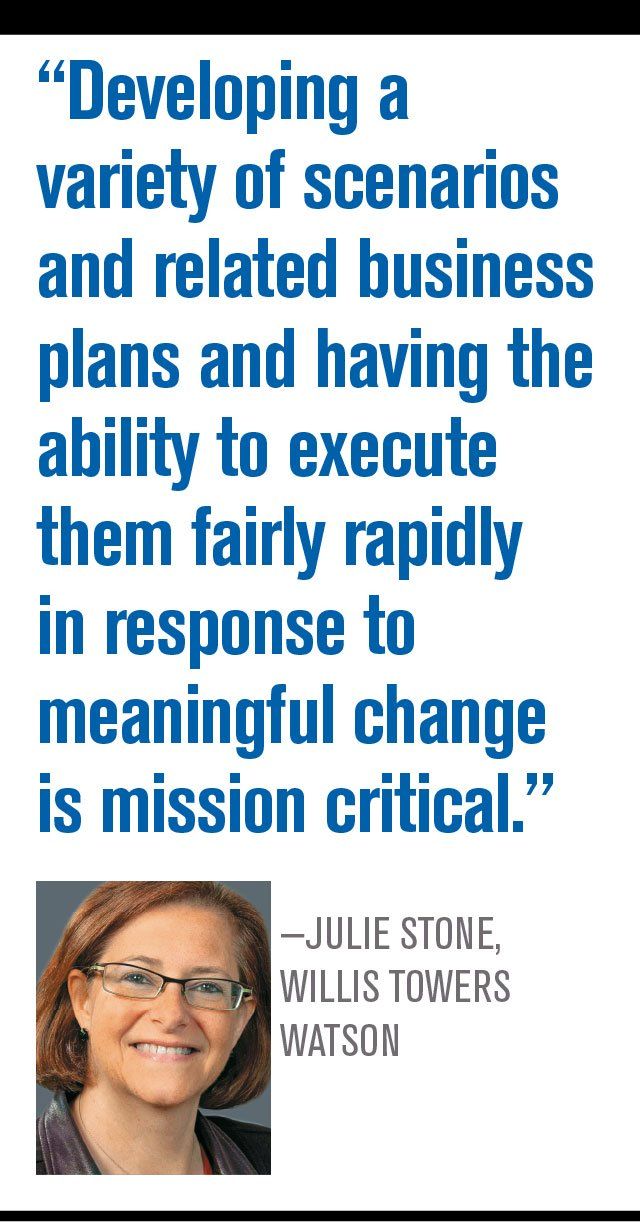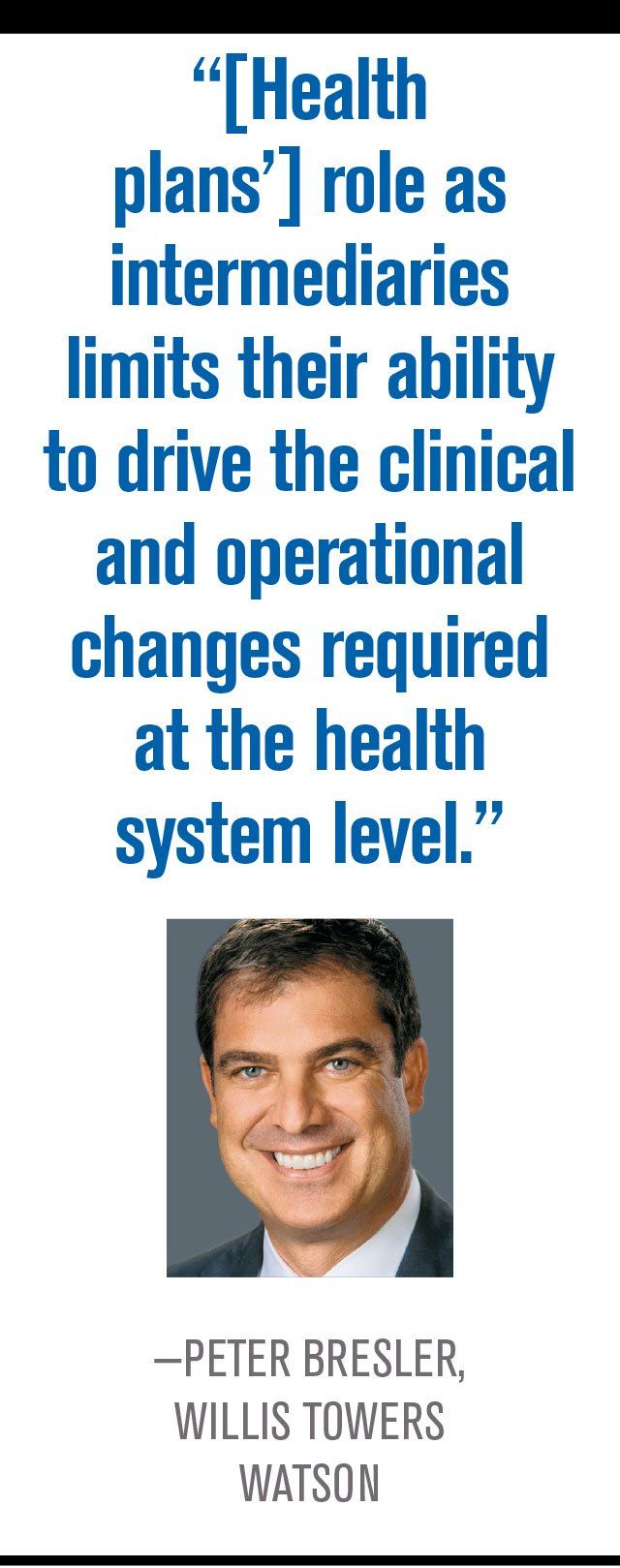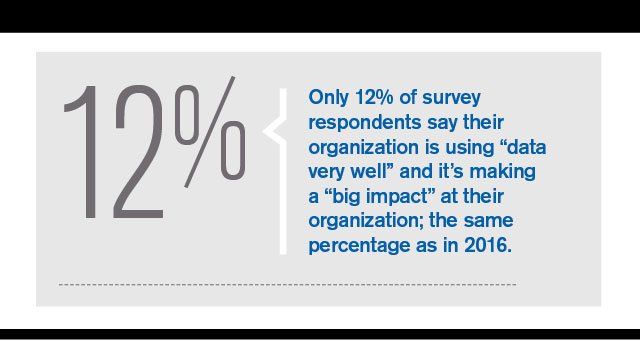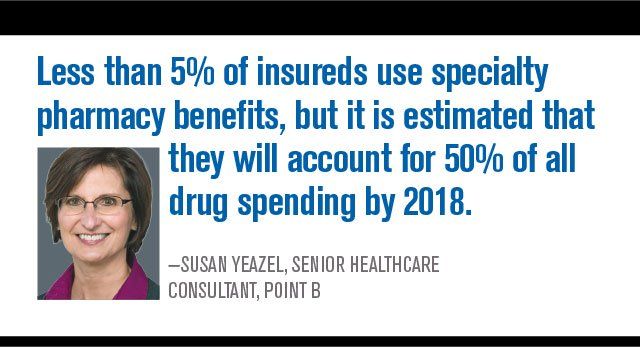Top 2018 challenges healthcare executives face
Experts weigh in on the findings from Managed Healtcare Executive’s 2017 State of the Industry Survey.
The future of the ACA was uncertain throughout 2017, and though President Trump recently took steps to dismantle it via executive order, it remains unclear how, and how soon, his actions will affect healthcare.
It should come as no surprise then that, according to Managed Healthcare Executive's 2017 State of the Industry Survey, government requirements and mandates top your list of challenges. In addition, shifting toward value-based care is high on the list, as is using big data to improve healthcare quality and reduce healthcare costs. Controlling rising specialty drug costs is another big burden.
The survey’s findings, based on more than 300 responses received during the third quarter of the year, show the biggest challenges that executives at health systems, health plans, pharmacy benefit organizations, and more are facing and anticipate continuing to face next year. Here's a closer look at the survey results, and what industry experts advise organizations to do to overcome these challenges.
Challenge #1: Complying with government requirements and mandates
Adhering to government requirements and mandates tops all challenges, at a whopping 34%. This is down just a tad from last year’s survey, when it was 36%. “The big question on everyone’s mind is, what will become of the ACA?” says Zach Hafner, national partner, consulting, Advisory Board, a healthcare consultancy firm. “Addressing this question at this point requires more precision because the government is deconstructing the broader legislation and taking on various components of it.”
President Trump recently announced he will end cost sharing reduction payments to insurers, and he scaled back requirements for employers to provide birth control as part of health coverage for employees. “But these aren’t the only potential targets; pre-existing conditions, mandatory insurance coverage, minimum policy inclusions, Medicaid expansion, and selling health insurance policies across state lines are all potential pressure points as the law is revisited and revised in the coming year,” Hafner says.
Next: How to overcome it
How to overcome it

Hafner advises focusing on what’s already known. “We actually know quite a bit about where things are headed; we just don’t know exactly what form they will take,” he says. “Most importantly, customers (i.e., consumers, employers, and both state and federal government entities) are not willing to absorb continued increases and are being proactive about pulling every lever at their respective disposal to manage costs. We also know that performance-based payment will increasingly be the norm, evidenced by the Medicare Access and CHIP Reauthorization Act (MACRA) passing with broad bipartisan support, and that unwarranted care variation drives higher costs-which no one is willing to pay for.”
Regarding the ACA, Julie Stone, North American health and benefits specialty practice leader, Willis Towers Watson, a healthcare advisory company, says executives should continue to plan for multiple scenarios. These range from legislative and regulatory status quo to full repeal with no replacement and several flavors in between. At press time, there is uncertainty about federal subsidies to offset individual out-of-pocket expenses for people who qualify continuing into 2018, as well as the potential impact on enrollment of reduced federal funding both prior to and concurrent with the open enrollment period.
Hafner advises proceeding with caution when it comes to the ACA. On the payer side, the public exchange is an important channel, but it will require continued government support to be sustainable. He also sees the potential for a sizable market opportunity for an individual healthcare product, since he says 22 million Americans stand to lose healthcare coverage if the ACA is repealed.
For providers, he advises focusing on delivering consistent, integrated, high-quality care. In the short term, the economics will have some volatility but over time, the rewards (i.e., customer loyalty, strategic partnerships, and expansion opportunities) will accrue to organizations demonstrating the greatest value propositions.
Stone points out that the pace of change in healthcare continues to accelerate on multiple fronts with a significant lack of transparency in the national legislative dialogue. “Developing a variety of scenarios and related business plans and having the ability to execute them fairly rapidly in response to meaningful change is mission critical,” she says.
Repeal of the ACA continues to be possible; the results of the mid-term election could be a game changer as could the White House shifting focus elsewhere-including tax reform.
Next: Challenge #2
Challenge #2: Implementing value-based reimbursement
Placing second among survey respondents’ biggest challenges is implementing value-based reimbursement, which received 22% of responses. Overall, more than half of survey participants, 56%, either have not yet started value-based payment initiatives or have only started a few initiatives. This does show some progress, as last year nearly 70% of survey respondents said they had not yet started or only had a few initiatives started.
Hafner says one reason organizations struggle in this area is that today’s fee-for-service system is not well aligned to deliver true value-based care, and for most provider and payer participants, most business remains fee-for-service. The country continues to tolerate fee-for-service and annual reimbursement increases. “Until that changes, we can’t really expect payers and providers to make the change,” he says.
Secondly, delivering value-based care requires different infrastructure, work flow, and information than what has been in place historically, all of which require investment. Some examples of this include physicians needing to collaborate, integrating clinical and financial data, and having the capability to evaluate, negotiate, and administer risk-based contracting arrangements. To date, the return on such investments has been elusive.
Thirdly, even after a decision is made to move a business model to value-based pay, data and insights needed are not easy to obtain and often considerable lag time occurs when compiling it.
Next: How to overcome it
How to overcome it

Peter Bresler, practice leader, health system consulting, Willis Towers Watson, points out that health plans have somewhat opposite challenges than health systems when it comes to value-based care, particularly with respect to the employer segment.
For years, major national carriers have served as the administrative and network partner for employers’ self-funded plans. They typically have deep knowledge and extensive relationships with employer decision-makers, and have been the first to introduce value-based arrangements to employers. “However, value-based care requires intensive clinical collaboration and a patient-centered focus, and carriers have been challenged to effectively drive these changes at health systems within their networks,” he says. “While there have been some success stories in driving value by carriers, through their experience in fully insured markets as well as with specialized buy-up care management programs, their role as intermediaries limits their ability to drive the clinical and operational changes required at the health system level.”
To succeed in the value-based world, health plan leaders need to develop a frank, honest perspective on where they have a unique, sustainable advantage for both payers and providers in the value-based world, and build their services and solutions around their strengths, says Bresler. For example, in some markets carriers may have an extremely well-developed network of hospitals and providers that offer high-quality, low-cost care. Their network depth and breadth can be leveraged in developing value-based offerings.
Anand Shroff, founder and chief development officer, Health Fidelity, a comprehensive risk adjustment solutions firm, says networkwide organizational alignment is key to overcoming challenges and succeeding in value-based care for payers and providers. “Designing processes that get rid of redundancies can save costs for both parties,” he says. “Creating financial incentive structures that successfully align the interests of provider groups and health plans will inherently build momentum toward the same outcome. Setting up a technology infrastructure where data sharing becomes effortless will be critical to removing the impediments that currently exist for organizations shifting toward value-based care.”
Next: Challenge #3
Challenge #3: Using big data to improve quality and reduce costs
This is a third major challenge facing organizations. Only 12% of survey respondents say their organization is excelling in this area; the same percentage as in the 2016 survey. Forty six percent of 2017 survey respondents say they “have come a long way” in this area, but that they have a lot more work to do in this space. That’s up from 39% last year.

Shroff sees two main big data challenges. Although more healthcare data is being generated, the data is scattered across multiple entities-payers, providers, and patients. There is no such thing as a single “source of truth” for healthcare data.
“When patients jump between different health plans or providers, the data doesn’t follow the patient,” he says. “This, coupled with the lack of interoperability between entities, makes it difficult to harness data-driven insights.”
Secondly, most organizations lack the proper technology to manage or capitalize on the vast amount of information they possess. Healthcare data comes in various formats and sources-clinical data from EHRs, billing data from claims, patient enrollment or registration data, as well as self-reported patient data, Shroff says. To truly unlock the power of big data, organizations need a technology infrastructure that retrieves, stores, and analyzes various sources of data at scale.
Health plans and systems have the same challenge-getting access to the data that the other has. “A health system has access to the patient’s most in-depth clinical data, but it’s often limited to the specific episode of care that was provided at that system,” Shroff says. “When a patient visits other provider groups or hospitals, it’s the patient’s responsibility to recall the care that was provided at the other settings.” On the other hand, health plans are aware of every encounter that a patient has, regardless of which system they visit. However, their depth of knowledge is limited to the billing data sent from the systems. “Having both entities share their respective data would most likely result in better quality and cost savings, but organizations are simply not set up to do so in today’s world.”
Next: How to overcome it
How to overcome it
Susan Yeazel, senior healthcare consultant, Point B, a management consulting firm, says organizations that successfully harness data for competitive advantages have executive leaders who embrace and are willing to invest in the value of data-driven decision making. An organization needs to identify the business objectives that will be achieved or enabled through data analytics, such as cost reduction, operational effectiveness, improved patient/member experience, employee engagement, or improved outcomes, and clearly establish the required analytic capabilities during the early planning stages on any data dependent initiatives. “Most importantly, success is dependent on weaving analytic capabilities throughout the organization through cultural adoption,” she says.
As technology and access to information continue to transform healthcare, Caroline Clouser, executive vice president, Chubb Healthcare, an insurance company, says executives need to embrace using these products and also ensure that they focus on the cyber threats associated with them. In addition to protecting healthcare data, they need to stay abreast of devices that have been reported as insecure and learn from vulnerabilities in order to mitigate future cyber risk.
Next: Challenge #4
Challenge #4: Controlling rising specialty drug costs
Sixteen percent of survey respondents say addressing rising pharmaceutical costs is their top challenge. Overall, regarding what will have the biggest impact on controlling rising specialty drug costs, 32% of survey participants say government interference. That’s about the same response as 2016, which was 33%. Other top responses included utilization management (19%); integrated pharmacy and medical benefits (17%); and cost-effective pharmacy plan design (16%). Those percentages were similar to last year, at 20%, 18%, and 15% respectively.

A proliferation of specialty drugs came to market in recent years, giving rise to many new high-profile treatments for complex health conditions, Hafner says. In some cases, new treatments for conditions that had none previously. These drugs often cost five or six figures, and account for an increasingly large portion of total pharmaceutical spend. They also represent nearly half of the new drugs currently in development.
Less than 5% of insureds use specialty pharmacy benefits, Yeazel says, but it is estimated that they will account for 50% of all drug spending by 2018. These drugs treat complex, chronic conditions such as certain types of cancer, hepatitis C, rheumatoid arthritis, and multiple sclerosis.
While healthcare systems are increasingly impacted by the rising costs of drugs, health plans are even more exposed. “They are struggling with the balance between providing patient choice to innovative cures and an increasing number of drugs that are simply not cost effective compared to existing treatments,” says Hunter Sinclair, senior engagement manager, Consulting, Advisory Board.
Next: How to overcome it
How to overcome it
One place health systems can turn to for inspiration around managing drug costs is large employer health plans. Many employers are doubling down on tools and tactics such as prescription quantity limits and stronger care management that ensure the right people get the most appropriate treatment, in the most appropriate setting, and that they adhere to it, says Benjamin Isgur, director, Health Research Institute, PwC, which analyzes trends affecting health-related industries.
Plans are even revisiting traditional strategies, such as requiring prior authorizations for specialty drugs; instituting step therapies, which require patients to try a less expensive drug before “stepping up” to a more expensive option; and limiting the number of drugs in an initial prescription to cut down on waste.
In addition, employers are working with plans to try to shift care to lower cost settings. One way to do this is by offering incentives in plan designs, such as gift cards or other types of payments or savings to steer volume. Treatments that require the help of medical personnel can be less expensive when administered outside of the hospital, Isgur says.
Employers should evaluate and address specialty drug cost and utilization performance through both their medical and pharmacy plans, advises Nadina J. Rosier, PharmD, health and group benefits practice leader, pharmacy, Willis Towers Watson. Moreover, they can implement more aggressive coverage changes and financial incentives to influence sites of care for specialty pharmacy through a medical benefit plan design. “As biosimilars become available, it is especially important to determine what health plans and pharmacy benefit managers are doing to promote them as clinically viable and low net cost options,” she says.
Karen Appold is a medical writer in Lehigh Valley, Pennsylvania.
Extending the Capabilities of the EHR Through Automation
August 2nd 2023Welcome back to another episode of "Tuning In to the C-Suite," where Briana Contreras, an editor of Managed Healthcare Executive, had the pleasure of chatting with Cindy Gaines, chief clinical transformation officer at Lumeon.
Listen